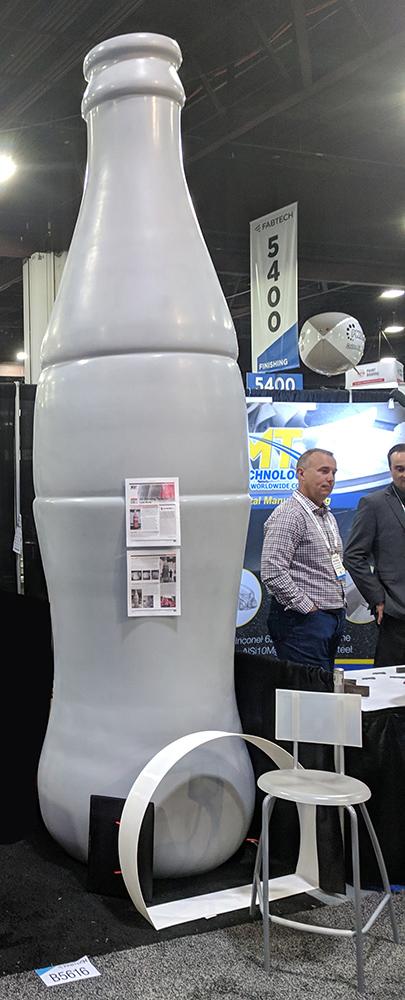Editor-in-Chief
- FMA
- The Fabricator
- FABTECH
- Canadian Metalworking
Our Publications
Categories
- Additive Manufacturing
- Aluminum Welding
- Arc Welding
- Assembly and Joining
- Automation and Robotics
- Bending and Forming
- Consumables
- Cutting and Weld Prep
- Electric Vehicles
- En Español
- Finishing
- Hydroforming
- Laser Cutting
- Laser Welding
- Machining
- Manufacturing Software
- Materials Handling
- Metals/Materials
- Oxyfuel Cutting
- Plasma Cutting
- Power Tools
- Punching and Other Holemaking
- Roll Forming
- Safety
- Sawing
- Shearing
- Shop Management
- Testing and Measuring
- Tube and Pipe Fabrication
- Tube and Pipe Production
- Waterjet Cutting
Industry Directory
Webcasts
Podcasts
FAB 40
Advertise
Subscribe
Account Login
Search
From undersized to oversized
FABTECH exhibitors show that 3D-printed parts come in a variety of sizes
- By Don Nelson
- November 14, 2018
The production of big and small parts intrigues me. The reason is because making an unconventionally sized part requires an extra dose of manufacturing know-how.
Extra thought must be given to handling oversized parts, for example, to prevent them from toppling and injuring operators. And large−often asymmetrical−workpieces can be difficult or impossible to mount on machines.
Smaller parts also pose workholding challenges. Typically they are too small to incorporate surfaces suitable for securing them to a machine. An additional concern is gripping force. Even the smallest amount of overgripping torque can damage a tiny workpiece.
My interest in oversized and undersized stuff extends to 3D-printed parts.
The largest printed object I saw in the 3D/Additive Manufacturing Pavilion at FABTECH® 2018, held Nov. 6-8 in Atlanta, was a 12-foot bottle. The smallest was a 4-millimeter-diameter gear.
3D PrintingTech, Atlanta, produced the bottle. It measures 12 ft. high by 3 ft. wide by 2 ft. deep and has 3-mm-thick walls printed from approximately 36 kilograms of PLA. The build time was 200 hours, said founding partner Josh Stover.
The shop used a 300-series Workbench Pro from 3D Platform to print the big bottle, which serves as the master for a mold. Stover said the shop separated the design into six sections to accommodate the 3D printer’s 1- by 1- by 0.7-m build envelope.
The smallest 3D-printed part I saw at FABTECH was a gear at the Nanogrande Inc. booth. Made of a tin-bismuth alloy powder on the Montreal company’s MPL-1 printing system, it measures 4 mm in diameter and comprises 25 layers, each 5 microns thick.
According to the company’s CEO, Juan Schneider, the MPL-1 can deposit layers with a thickness equaling that of the build-powder particles. He credited the company’s Power Layering Technology™ for allowing this by overcoming the van der Waal forces that limit the compaction of particles.
Before introduction of the technology, said Schneider, particles less than 17 µm turned into “clumpy mud” when printed.
“With this approach, we can easily print with particles as small as a nanometer, but also particles of 5 microns, [which is] what the industrial sector is currently seeking,” he said. “At this size, the particles stick to each other, virtually eliminating the need for support structures typical to 3D printing.”
About the Author

Don Nelson
2135 Point Blvd.
Elgin, IL 60123
(815)-227-8248
About the Publication
- Podcasting
- Podcast:
- The Fabricator Podcast
- Published:
- 04/16/2024
- Running Time:
- 63:29
In this episode of The Fabricator Podcast, Caleb Chamberlain, co-founder and CEO of OSH Cut, discusses his company’s...
- Trending Articles
- Industry Events
16th Annual Safety Conference
- April 30 - May 1, 2024
- Elgin,
Pipe and Tube Conference
- May 21 - 22, 2024
- Omaha, NE
World-Class Roll Forming Workshop
- June 5 - 6, 2024
- Louisville, KY
Advanced Laser Application Workshop
- June 25 - 27, 2024
- Novi, MI




























